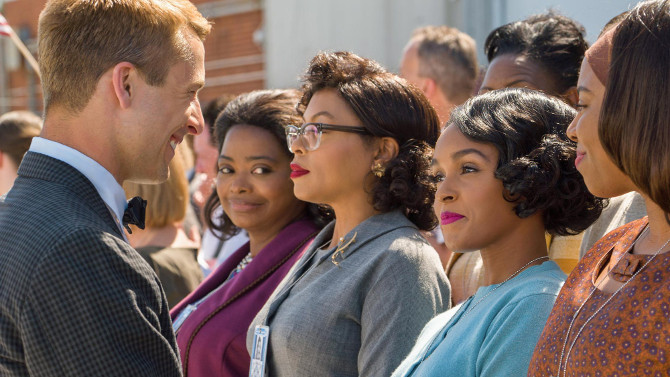The title of Hidden Figures, one of 2017’s Academy Award Best Picture nominees, has a double meaning. Speaking to the mathematics that is at the heart of the space travel film, it more subtly references the story of its three African American female leads, who, despite playing a big part in Space Race history, have been lost to time. . . until now.
Depicting the combative duality of the Cold War, writer/director Theodore Melfi (who adapts Margot Lee Shetterly’s book of the same name, along with Allison Schroeder) captures the essence of this complicated time. On the surface, it is America versus Soviet Union – funnelled through the propaganda-filled battle that centres around who will win the Space Race; though, more specifically, it portrays the Civil Rights battle, a world where, in 1961 Virginia, everything is still segregated. Written with deft precision, dialogue like “Civil Rights ain’t always civil”, which is uttered by Levi Jackson (Aldis Hodge), succinctly represents this era; while a scene that appears towards the end, where mathematician Katherine G. Goble (Taraji P. Henson) hurriedly delivers some updated calculations for John Glenn’s (Glen Powell) all important mission – only to have the door slammed in her face after all of the white personnel have been ushered into the room, highlights the atrocities and unfairness of the era, while also showing how far we have come and how much farther we still have to go.
Following a sepia-tinged flashback that introduces us to Goble as a young child, we then find our three leads stranded on the side of the road on the way to NASA. Goble is a mathematical prodigy, Dorothy Vaughan (Octavia Spencer) an unofficial supervisor working two jobs (while only getting paid for one), and Mary Jackson (Janelle Monáe) is driven, against all odds, to become an engineer; together they push themselves to reach for the stars – despite the fact that the stars are white and they are not.
With NASA in full desperation mode after Russian Yuri Gagarin became the first man in space, Goble is invited into the Space Task Group, run by the project-driven Al Harrison (Kevin Costner). The first coloured woman to work there, she is greeted by dirty looks and a cold, uncomfortable vibe, taken to task at every turn by reluctant superior Paul Stafford (Jim Parsons). Things are no easier at home; a widow, she has to nurture and provide for three young girls. Soon, her friends are trying to set her up with Colonel Jim Johnson (Mahershala Ali), a charming, stable and very proper gentleman.
Dorothy Vaughan, struggling to deal with her supervisor Vivian Mitchell (Kirsten Dunst) – who seems unsympathetic towards her and ‘her girls’ (other black women working at NASA) plight, sees the incoming IBM computer as a sort of impending doom (as it will be the end of all their jobs). Turning her mind towards becoming supremely knowledgeable about the newfangled machine, she trains her friends so that they too will have a step up on everyone else who will be brought in to run it. Another quotation that perfectly sums up Vaughan’s fight finds Mitchell telling her “despite what you may think, I have nothing against y’all.” She cleverly responds, “I know you probably believe that”, which speaks to the ingrained nature of racism.
Mary Jackson, mentored by scientist Karl Zielinski (Olek Krupa), has been guided down a path that should lead her to become an engineer, however, there are countless obstacles along the way (she would have to become the first African American woman allowed to attend an all-white school in Virginia, as well as the first black female to be an engineer at NASA). With a swagger and mouth to go with it, she speaks her mind, sometimes to her own detriment.
A feel good story, despite showing the stupidity and hatred of the time, it more importantly demonstrates the brave souls of these three extraordinary women, as well as those who chose to ignore the colour of peoples’ skin as well as their gender – taking strides to break down barriers so that the most talented individuals could do the job to combat another oppressive power. Superb scenes abound; just one being when Harrison violently rips down the sign that signifies that bathrooms are segregated (a huge step for Goble – who has to run half a mile every time she needs to relieve herself). He ends it by saying, “here at NASA we all pee the same colour”. Glenn is another refreshing sight. As he makes his first visit to NASA, his goofy charm and accepting persona brings him to greet all of the black employees – the only one to do so. He truly is Goble’s biggest supporter – seeing her for what she is: a bright woman whose smarts are head and shoulders above the rest.
Featuring a more than solid ensemble cast (there are no weak performances here), direction that transports you back to the early 1960s, music and songs that encapsulate what we are seeing, as well as an engaging story, Hidden Figures takes us into the lives of these amazing people who helped propel NASA into space. There’s no need to fudge the numbers; take this pearl of wisdom, see Hidden Figures to learn about a story that was written in the stars.


This was a good movie. It was entertaining and provided me with a history lesson on
NASA, with interesting information on this particular space mission, which I was not at all aware of. What an amazing group of brilliant ladies! I’m always amazed at how ignorant we are as humans – treating others who are different from us (colour, religion,etc.) with such disdain and disrespect . . . and continue to do so; though hopefully not as much.